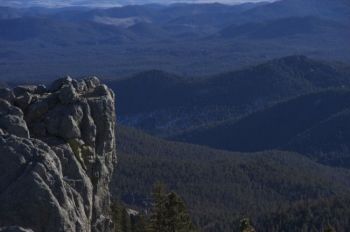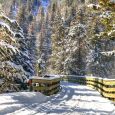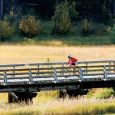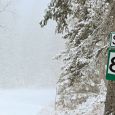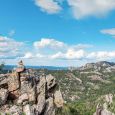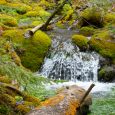The Gift of South Dakota
Subscriptions to South Dakota Magazine make great gifts!
Subscribe today — 1 year (6 issues) is just $29!
Quiet, Beauty and Snow
“How does it feel," my companion asked as he sipped coffee at dawn, "to be perched on the edge between heaven and earth?"
The assessment seemed right, for several reasons. The most immediate was our sunrise breakfast on a high-pitched ledge of rock on the eastern slopes of the Black Hills. There was fire in the sky that morning as the flaming sun rolled over the dim horizon, as the lower sky broke into a radiant orange, as the last of the morning stars glimmered in the cobalt-blue expanse of the infinite overhead.
We had spent the night on the shelves of this cliff some 6,000 feet up, and there wasn't much between us and the towering South Dakota sky. Harney Peak, which at 7,242 feet is the highest point east of the Rockies, was an over-the-shoulder glance behind us. We could survey bony outcroppings of granite thousands of feet below. The world had been laid at our feet.
But the sense of being poised between heaven and earth had as much to do with the character of this landscape — the Black Elk Wilderness Area — as it did with our aerie lookout to watch the turning of the celestial orbs. Some say the place is sacred. The Black Elk Wilderness Area is at the heart of the Black Hills which were held in holy trust by the Native Americans who lived for thousands of years on the plains surrounding them. Not only did the area provide an abundance of needed game, plant life and seasonal refuge, but it was also believed to be an especially sacred area.
It was a place for seeking visions — often at the summit of Harney Peak, known in various Plains Indian dialects as the "tall rock mountain at the center of the world." Now comprising over 13,000 acres of undeveloped national forest land, the area was named in 1980 for the Lakota holy man whose life story is chronicled in John Neihardt's classic Black Elk Speaks.
The feeling that these woods, these rocks, these meadows are special persists today. Even those who are less romantic, less sentimental about the natural landscape will admit sensing something different here. Others will tell you the preserve (like Bear Butte to the north or the Stone Medicine Wheel in Wyoming's nearby Big Horns) is among the world's sacred spots. Those who are inclined toward the mystical may report extraordinary soundings in these woods, and earnest New Agers appreciate the sense of place and point to the glittering mica and quartz crystal found here.
Of course, my companion and I did not hold such lofty views a few mornings prior to that luminous dawn watch. We had awakened to snow. Maybe three inches. Startling our stockinged feet. Draped generously on our tent. Blanketing our metal cook gear.
This was not our first trip to the Black Elk area in late fall or early winter, and each time we had just missed heavy snowfalls. Feeling either lucky or blessed we kept coming back, largely because we like the Hills this time of year. The temperatures are brisk but pleasant and the place is mostly empty.
One of the main advantages of this wilderness area is its accessibility: the highest reaches are but a day's hike from the car. An elaborate trail system networks the wilderness area with the surrounding forest lands as well as Mount Rushmore, Custer State Park and Wind Cave National Park. It also splices into the Centennial Trail which runs the length of the Black Hills from north to south.
But the accessibility is also one of the area's biggest drawbacks: backcountry backpacking and solitude can be quickly undercut by trooping vacationers, picnickers and day hikers. Even Harney Peak's summit, capped with a stone lookout tower built in 1938 but no longer used, is an afternoon's jaunt from a parking lot. So we come in autumn and take our chances with shifting winds, and waking occasionally to ice in our water bottles.
And there we were now, waking to a snow-laden landscape after star-gazing the night before. So we cooked breakfast in the cold, wet snow and ate in the snow and took our tent down in the snow and hiked all morning in the snow — in a grey and white wonderland of pine, birch and oak, and big, heavy flakes, under a low-hanging sky of slate-grey.
But by early afternoon the beauty and novelty weren't enough to offset the soggy boots and numbing toes, and a closing-in sense of foreboding. After a chilly lunch, we stood in a bitter wind and looked at the cold, grey day and kicked at the three-inch snow as if it would tell us how long the storm would last.
There are no weather reports in the woods and not much sky when you're hiking the shoulders and ravines of precipitous forestland. We didn't know what to do — head for cover or carry on?
But before we had to choose between foolhardy courage and cowardly caution, a patch of white clouds appeared. Then a window of blue sky. Then a puddle of sunlight. And by midafternoon the storm had passed through and the sky was clear and the sunset was brilliant.
We set up camp that evening in a gold grass meadow, laid out our sleeping bags to dry, and scrambled up some rocks for a cocktail hour of Gatorade and trail mix. The vista was stunning — red sun sinking in the west, full white moon rising over rocky peaks in the east. Luminescent.
I like being in a place where I am not confined to campgrounds, but am left to my own allegiance to low-impact camping. I like to get off the trail and explore a bit, whether it's struggling to the top of Little Devil's Tower, finding a perch to admire Cathedral Spires, or climbing around on the huge slabs of granite scattered about the area.
One of my favorite features of the Black Elk Wilderness are the rock formations — giant boulders and splintery crags, projectile needles and weathered knobs. They will make you stop and stare. And think. These fingers and fists emerged from a seabed as a great dome of molten rock plunged through and transformed the layers of limestone and sandstone sediments laid down 600 to 700 million years ago. Erosion and weathering have left the granite pegmatite exposed and gnarly and wondrous. But then I favor rocks.
There is also a fair amount of wildlife here — ground mammals, deer, wild turkey, beaver, an occasional elk or bobcat or mountain goat, bald and golden eagles. But the main attraction, it seems to me, is something which comes through the soles of the feet when you have hiked here awhile, or through the pores when you least expect it. It is an awareness that there is more here than might be detected through our meager senses — something luminous, something of the heart of the place, something which puts you in touch with both the earth and sky.
Editor's Note: Kerry Temple lives in South Bend, Indiana, where he is editor of Notre Dame Magazine. This story originally appeared in the November/December 1992 issue of South Dakota Magazine. To order a copy or to subscribe, call 800-456-5117.


